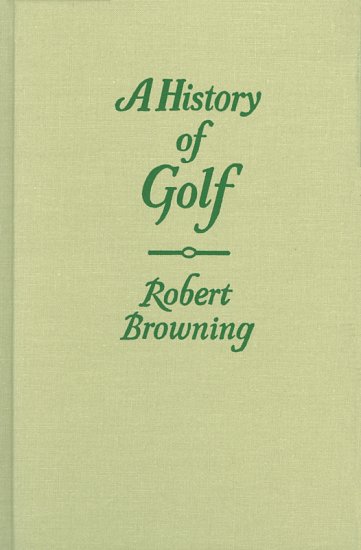A History of Golf (1955)
$35.00
Out of stock
By Robert Browning
Robert Browning served as editor of Golfing magazine in London for 45 years, accumulating in that time a tremendous ability to ferret out golf facts and an unsurpassed breadth of knowledge about the game. Published the year he retired, A History of Golf is the culmination of Browning’s lifelong study, passion and work. According to the esteemed Herbert Warren Wind, it “is in a class by itself; it is far and away the finest one-volume history of golf.” This is not a history of golfers. Many of the great players are mentioned and their exploits touched upon, but this information is included solely to help document the game’s evolution. The title of the book belies its depth; it is a complete history of golf, yet far from boring. While thousands of historical events are related, Browning also explains how these incidents fostered the development of the game. Presenting facts in the context golf’s evolution gives them life and meaning unobtainable by mere listing.
Browning’s engaging style is further enhanced by the method he uses to organize and divide his subject matter into manageable bites.
Each book chapter covers a period ranging from 44 years to 284 years, averaging around a century-and-a-half. The format of overlapping sequences gives A History of Golf an unparalleled continuity. The reader understands how the whole fabric of golf is woven—and how the beauty of the tapestry is created as the individual threads appear and disappear. The book is also invaluable as a research tool. Its division into specific subject matters and chronological arrangement makes it an especially useable reference. Herbert Warren Wind has confided it is one of the three most useful books on his shelves*. It boasts a thorough index and, for quick reference, an appendix listing over 150 important events arranged by dates. The wealth of information in this book is staggering, but within his crisp historical prose are scatted enough amusing anecdotes to keep one interested and entertained.
NOTE: Herbert Warren Wind’s three most referenced books are
- Robert Browning’s A History of Golf
- Peter Ryde and Donald Steel’s The Encyclopedia of Golf
- The New World Atlas of Golf, edited by Pat Ward Thomas, Wind, Charles Price and Peter Thomson.
Browning takes particular care in the initial chapters to explain the vague origin of the game and chronicle all known claims of invention. This is scholarly work and dispels many of the false assertions that have persisted through the years. One of the problems that has plagued reporting and writing since its invention has been the insufficiency of original inquiry by authors. Pressed for time, out of ignorance, or merely out of laziness, writers may rely on previous works for information and statistics, or worse, report hearsay as fact. This was a particular gripe of Browning, an indefatigable researcher, perhaps the most thorough in the history of golf literature. “Not many years ago a Scottish daily paper which ought to have known better published an article containing a reference to a ‘tradition’ that golf was introduced into Scotland by the Dutch workmen brought over by King Robert Bruce after the battle of Bannockburn to commence the building of St. Andrews Cathedral. It would be difficult to cram a greater number of chronological inexactitudes into a single sentence, but inaccuracies will attach themselves to the best regulated tradition.”
Vagaries persist through the early days of Scottish golf, but as clubs were officially established and records kept, the factual foundation of golf becomes more solid. Writers often describe how golf has affected society at large, but Browning also verifies the reverse: that the formation of golfing societies changed golf. The Statistical Account of Scotland records events at Leith, one of the earliest golfing grounds. “All distinctions of rank were leveled by the joyous spirit of the game. Lords of Session and cobblers, knights, baronets, and tailors might be seen earnestly contesting for the palm of superior dexterity, and vehemently but good-humouredly discussing moot points of the game, as they arose during the course of play.” But this paradise “was too fine to last; the Club system made an end of it at Leith as it has done elsewhere.”
As golf was transplanted to England, Europe, Ireland, the United States and the world, the story and its telling become most interesting and animated, making up the largest portion of the history. Specific chapters on the earliest golf in America, and Browning’s account of how the country came to dominate the game are fascinating. Thanks to his wide range of knowledge and talent for focusing on the interesting, A History of Golf never fails to put facts in perspective. Mankind has always forged ahead, sought challenges. While in one sense nothing has changed in golf, actually everything has changed. Lament if you will the passing of the rugged days of spirited adventure, but also realize the modern game is a more severe test, the golfer allied with technology facing a craftier adversary in the designed course. Such is the latest chapter in the history of golf.
Out of stock
Additional information
| Weight | 3 lbs |
|---|

